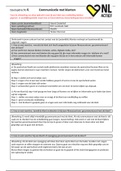Samenvatting
2.2: Network Governance: Summary of reading material and lectures
- Instelling
- Erasmus Universiteit Rotterdam (EUR)
This is a complete and up-to-date summary of the relevant chapters of the required readings used in the course Network Governance, plus notes from the lectures.
[Meer zien]














